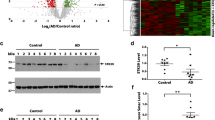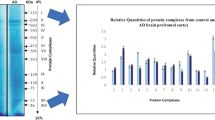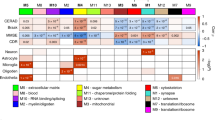Abstract
Alzheimer’s disease (AD), a progressive neurodegenerative disorder and the most common form of dementia and cognitive impairment is usually characterized by neuritic amyloid plaques, cerebrovascular amyloidosis and neurofibrillary tangles. In order to find out the pathological protein expression, a quantitative proteome analysis of AD hippocampus, substantia nigra and cortex was performed and the extent of protein expression variation not only in contrast to age-matched controls but also among the understudied regions was analyzed. Expression alterations of 48 proteins were observed in each region along with significant co/contra regulation of malate dehydrogenase, lactate dehydrogenase B chain, aconitate hydratase, protein NipSnap homolog 2, actin cytoplasmic 1, creatine kinase U-type and glyceraldehyde-3-phosphate dehydrogenase. These differentially expressed proteins are mainly involved in energy metabolism, cytoskeleton integration, apoptosis and several other potent cellular/molecular processes. Interaction association network analysis further confirms the close interacting relationship between the co/contra regulated differentially expressed proteins among all the three regions. Elucidation of co/contra regulation of differentially expressed proteins will be helpful to understand disease progression and functional alterations associated with AD.



Similar content being viewed by others
Abbreviations
- 2DE:
-
Two dimensional gel electrophoresis
- AD:
-
Alzheimer’s disease
- ESI-QTOF-MS/MS:
-
Electrospray ionization quadrupole time of flight tandem MS
References
Aitken A, Collinge DB, van Heusden BP, Isobe T, Roseboom PH, Rosenfeld G, Soll J (1992) 14-3-3 proteins: a highly conserved, widespread family of eukaryotic proteins. Trends Biochem Sci 17:498–501
Asif AR, Oellerich M, Amstrong VW, Gross U, Reichard U (2010) Analysis of the cellular Aspergillus fumigatus proteome that reacts with sera from rabbits developing an acquired immunity after experimental aspergillosis. Electrophoresis 31:1947–1958
Bekris LM, Yu CE, Bird TD, Tsuang DW (2010) Genetics of Alzheimer disease. J Geriatr Psychiatry Neurol 23:213–227
Blum H, Beier H, Gross HJ (1987) Improved silver staining of plant proteins, RNA and DNA in polyacrylamide gels. Electrophoresis 8:93–99
Braak H, Braak E (1991) Neuropathological stageing of Alzheimer-related changes. Acta Neuropathol 82:239–259
Bürklen TS, Schlattner U, Homayouni R, Gough K, Rak M, Szeghalmi A, Wallimann T (2006) The creatine kinase/creatine connection to Alzheimer’s disease: CK-inactivation, APP-CK complexes and focal creatine deposits. J Biomed Biotechnol 2006:35936
Castegna A, Thongboonkerd V, Klein JB, Lynn B, Markesbery WR, Butterfield DA (2003) Proteomic identification of nitrated proteins in Alzheimer’s disease brain. J Neurochem 85:1394–1401
Chuang DM, Hough C, Senatorov VV (2005) Glyceraldehyde-3-phosphate dehydrogenase, apoptosis, and neurodegenerative diseases. Annu Rev Pharmacol Toxicol 45:269–290
Cumming RC, Schubert D (2005) Amyloid-beta induces disulfide bonding and aggregation of GAPDH in Alzheimer’s disease. FASEB J 19:2060–2062
Davies CA, Mann DM, Sumpter PQ, Yates PO (1987) A quantitative morphometric analysis of the neuronal and synaptic content of the frontal and temporal cortex in patients with Alzheimer’s disease. J Neurol Sci 78:151–164
Ferreira IL, Resende R, Ferreiro E, Ergo AC, Pereira CF (2010) Multiple defects in energy metabolism in Alzheimer’s disease. Curr Drug Targets 11:1193–1206
Gandy S (2005) The role of cerebral amyloid beta accumulation in common forms of Alzheimer disease. J Clin Invest 115:1121–1129
Gohla A, Bokoch GM (2002) 14-3-3 regulates actin dynamics by stabilizing phosphorylated cofilin. Curr Biol 12:1704–1710
Halpain S, Hipolito A, Saffer L (1998) Regulation of F-actin stability in dendritic spines by glutamate receptors and calcineurin. J Neurosci 18:9835–9844
Holtzman DM, Morris JC, Goate AM (2011) Alzheimer’s disease: the challenge of the second century. Sci Transl Med 3:77sr1
Jensen LJ, Kuhn M, Stark M, Chaffron S, Creevey C, Muller J, Doerks T, Julien P, Roth A, Simonovic M, Bork P, von Mering C (2009) STRING 8—a global view on proteins and their functional interactions in 630 organisms. Nucleic Acids Res 37: (Database issue) D412–D416
Mazzola JL, Sirover MA (2001) Reduction of glyceraldehyde-3-phosphate dehydrogenase activity in Alzheimer’s disease and in Huntington’s disease fibroblasts. J Neurochem 76:442–449
Naletova I, Schmalhausen E, Kharitonov A, Katrukha A, Saso L, Caprioli A, Muronetz V (2008) Non-native glyceraldehyde-3-phosphate dehydrogenase can be an intrinsic component of amyloid structures. Biochim Biophys Acta 1784:2052–2058
Obulesu M, Venu R, Somashekhar R (2011) Tau mediated neurodegeneration: an insight into Alzheimer’s disease pathology. Neurochem Res 36:1329–1335
Planel E, Miyasaka T, Launey T, Chui DH, Tanemura K, Sato S, Murayama O, Ishiguro K, Tatebayashi Y, Takashima A (2004) Alterations in glucose metabolism induce hypothermia leading to tau hyperphosphorylation through differential inhibition of kinase and phosphatase activities: implications for Alzheimer’s disease. J Neurosci 24:2401–2411
Reilly JF, Games D, Rydel RE, Freedman S, Schenk D, Young WG, Morrison JH, Bloom FE (2003) Amyloid deposition in the hippocampus and entorhinal cortex: quantitative analysis of a transgenic mouse model. Proc Natl Acad Sci USA 100:4837–4842
Reitz C, Brayne C, Mayeux R (2011) Epidemiology of Alzheimer disease. Nat Rev Neurol 7:137–152
Rhein V, Baysang G, Rao S, Meier F, Bonert A, Müller-Spahn F, Eckert A (2009) Amyloid-beta leads to impaired cellular respiration, energy production and mitochondrial electron chain complex activities in human neuroblastoma cells. Cell Mol Neurobiol 29:1063–1071
Rinne JO, Rummukainen J, Paljärvi L, Säkö E, Mölsä P, Rinne UK (1989) Neuronal loss in the substantia nigra in patients with Alzheimer’s disease and Parkinson’s disease in relation to extrapyramidal symptoms and dementia. Prog Clin Biol Res 317:325–332
Roth D, Birkenfeld J (1999) Betz H dominant-negative alleles of 14-3-3 proteins cause defects in actin organization and vesicle targeting in the yeast Saccharomyces cerevisiae. FEBS Lett 460:411–416
Sultana R, Boyd-Kimball D, Cai J, Pierce WM, Klein JB, Merchant M, Butterfield DA (2007) Proteomics analysis of the Alzheimer’s disease hippocampal proteome. J Alzheimers Dis 11:153–164
Umahara T, Uchihara T, Tsuchiya K, Nakamura A, Iwamoto T, Ikeda K, Takasaki M (2004) 14-3-3 proteins and zeta isoform containing neurofibrillary tangles in patients with Alzheimer’s disease. Acta Neuropathol 108:279–286
Werner CJ, Heyny-von Haussen R, Mall G, Wolf S (2008) Proteome analysis of human substantia nigra in Parkinson’s disease. Proteome Sci 6:8
Zahid S, Oellerich M, Asif AR, Ahmed N (2012) Phosphoproteome profiling of substantia nigra and cortex regions of Alzheimer’s disease patients. J Neurochem 121:954–963
Acknowledgments
The authors thank, MRC Sudden Death Brain Bank, Department of Neuropathology, The University of Edinburgh for providing brain specimens used for this study. The work was supported by research grant to N.A. Grant No. 20-560/R&D/07 and research grant to S.Z. under the International Research Support Initiative Program (IRSIP) from Higher Education Commission, Pakistan.
Conflict of interest
The authors have declared no conflict of interest.
Author information
Authors and Affiliations
Corresponding authors
Additional information
Abdul R. Asif and Nikhat Ahmed have contributed equally to this work.
Electronic supplementary material
Below is the link to the electronic supplementary material.
Rights and permissions
About this article
Cite this article
Zahid, S., Oellerich, M., Asif, A.R. et al. Differential Expression of Proteins in Brain Regions of Alzheimer’s Disease Patients. Neurochem Res 39, 208–215 (2014). https://doi.org/10.1007/s11064-013-1210-1
Received:
Revised:
Accepted:
Published:
Issue Date:
DOI: https://doi.org/10.1007/s11064-013-1210-1




